Published 04 Apr 2025
Mastering DeFi Risk: What Every Investor Should Know

In traditional finance, tools like credit ratings and volatility indexes help investors measure risk and make informed decisions. But DeFi operates by different rules — smart contract vulnerabilities, liquidity shortages, and governance risks create a complex environment that traditional risk models fail to capture.
That’s why RateX Network developed the RateX Score — a DeFi-specific risk assessment system that analyzes thousands of on-chain and off-chain factors. Our ratings simplify complex data into clear, actionable insights, helping investors evaluate DeFi assets, protocols, blockchains, and liquidity pools with confidence.
This guide will show you how RateX Score can be your key to safer, smarter DeFi investing.
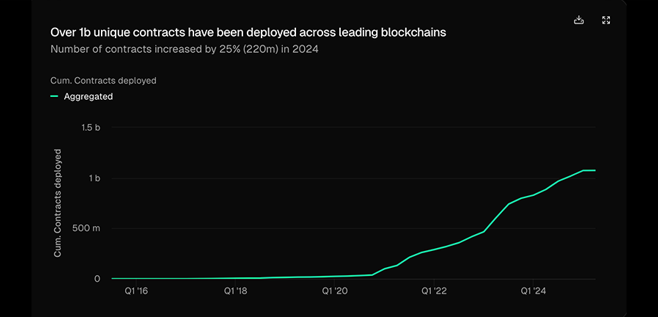
Understanding Risk in DeFi: A New Approach
More than one billion smart contracts have been deployed across major blockchains, with 220 million added in 2024 alone — a 25% increase in just one year. This rapid expansion signals the growing shift of financial activity on-chain, but it also highlights the urgent need for a new approach to risk assessment in decentralized finance.
In traditional markets, centralized institutions enforce regulations and provide oversight, reducing many risk factors. DeFi, on the other hand, operates without intermediaries, creating both opportunities and significant challenges. Traditional risk models, built for centralized finance, struggle to account for DeFi’s unique risks:
- Decentralization: No single authority enforces standards or intervenes in crises.
- Smart Contracts: A single vulnerability can result in instant losses.
- Anonymity: Bad actors can execute rug pulls or governance attacks with little accountability.
- Composability: Interconnected protocols mean that one failure can trigger a domino effect across multiple platforms.
In 2022 alone, DeFi users lost over $3 billion due to hacks and exploits (Chainalysis). Despite these risks, DeFi remains a transformative financial frontier — and those equipped with the right tools can navigate it safely and profitably.
RateX Score: AI-Powered Risk Intelligence for Web3
Understanding risk in DeFi is more than just analyzing smart contracts — it requires a deep, multi-layered approach that factors in market activity, social sentiment, and liquidity shifts. Traditional risk assessment tools struggle to keep up with the dynamic and decentralized nature of Web3. That’s where RateX Score, powered by the Meta Scoring Engine, transforms the game.
A Smarter Way to Assess Risk
Unlike conventional rating systems that rely solely on on-chain metrics, RateX Score integrates:
- 3 billion on-chain transactions for real-time market visibility
- 200 million wallet activities to track major holders and liquidity flows
- Billions of social media posts to gauge sentiment and detect potential risks early
- 70+ advanced metrics that provide a holistic view of digital asset risk
How RateX Score Works
- AI-Driven Risk Identification – Autonomous agents analyze token performance, whale movements, and liquidity trends.
- Data Fusion & Scoring – A proprietary AI model synthesizes market intelligence, producing a dynamic risk rating.
- Actionable Insights – Users can ask natural language questions and receive AI-generated insights tailored to their needs.
The Power of Meta Scoring
RateX Score doesn’t just label assets as high or low risk — it provides a real-time, adaptive risk profile that evolves with market conditions. This means traders, funds, and developers can make informed decisions based on institutional-grade intelligence, without needing deep coding or specialized expertise.
By combining AI automation, social sentiment analysis, and blockchain data, RateXAI democratizes risk intelligence, making it accessible to anyone looking to navigate DeFi safely and strategically.
Risk Across Core DeFi Sectors: Where Capital Flows Now
In today's DeFi landscape, capital is increasingly flowing toward lower-risk, yield-generating strategies — namely staking, lending, market making, and bridging. These categories have emerged as the foundational “jobs” of DeFi, each offering distinct risk/reward profiles.
At RateX, we track these shifts closely through our Meta Scoring Engine, identifying where real yield comes from — not through token emissions, but through organic, on-chain activity. This marks a maturing DeFi ecosystem, where protocols compete on efficiency and sustainability, not hype.
By understanding the function and risk behind each of these DeFi jobs, investors can optimize yield without blindly chasing APY — and with RateX Score, they can do so with AI-powered confidence.
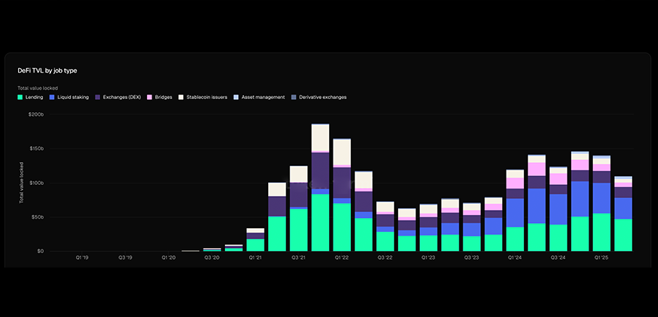

A Shift Toward Sustainable Yield Models
In the early days of DeFi, protocols heavily relied on token incentives to bootstrap liquidity and attract users. While this method initially fueled rapid growth, it often led to unsustainable token emissions, devaluing assets and creating short-lived incentives. Over the past year, the landscape has evolved, with a clear shift towards fee-driven yield models that prioritize long-term sustainability. This transformation reflects the growing maturity of the DeFi ecosystem, where projects now focus on organic revenue generation rather than temporary token-based rewards.
Efficiency Over Emissions: The New DeFi Standard
This industry-wide transition mirrors broader market trends, as users increasingly prioritize sustainable yields over short-term rewards. Today, leading protocols like Lido, Uniswap, and Aave prove that real, fee-based revenue models aren’t just possible—they’re becoming the cornerstone of DeFi’s long-term value creation. Instead of competing through token emissions, projects now strive for capital efficiency and revenue transparency, marking a new era of economic maturity in decentralized finance.
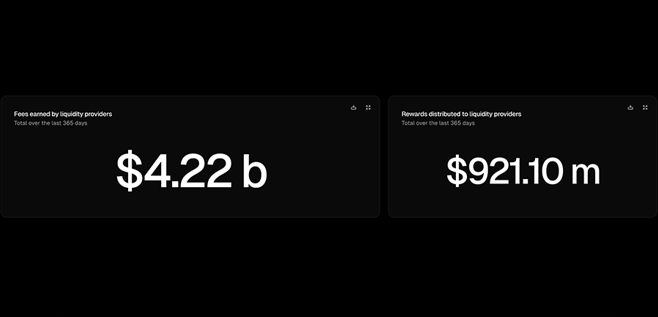
Staking: The Backbone of DeFi — and Its Risks
Staking plays a critical role in validating transactions and securing blockchain networks. As validators confirm activity, they earn a share of transaction fees, making staking both foundational and rewarding. Ethereum’s transition to Proof-of-Stake has turbocharged this sector, with the total amount of staked ETH more than doubling since the Merge. Today, staking leads the DeFi landscape, with over $60 billion locked in liquid staking protocols.
Much of this momentum is driven by Liquid Staking Tokens (LSTs), which let users earn staking rewards while maintaining access to their assets—blending yield and flexibility in one instrument. But with growth comes scrutiny.
What About Risk?
One of the primary concerns in staking is vslashing — penalties imposed on validators for malicious or faulty behavior. Yet, real-world data tells a reassuring story: slashing events are extremely rare. Since Ethereum’s Beacon Chain launch in 2020, fewer than 0.04% of validators have been slashed, and in 2024, that number dropped to just 0.01%**. These figures highlight the increasing resilience and reliability of today’s staking infrastructure.
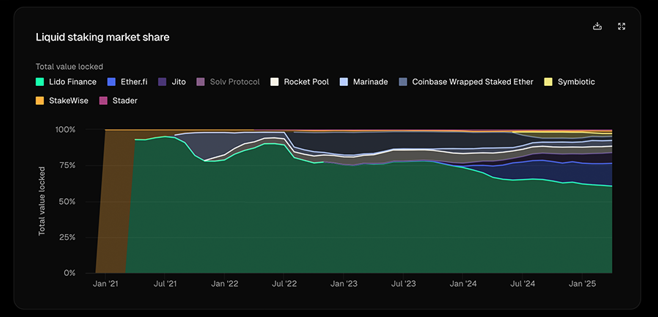
Staking Yields: The On-Chain Benchmark
In the world of decentralized finance, staking yields — powered by token emissions, transaction fees, and Maximal Extractable Value (MEV)—have emerged as the on-chain equivalent of U.S. Treasury rates in traditional markets. These base yields serve as a foundational benchmark for DeFi activity.
At the heart of this evolution lies the Liquid Staking Token (LST) ecosystem. LSTs allow users to participate in staking while retaining liquidity through tokenized, tradeable receipts. This dual benefit — yield + flexibility — has helped position staking as a central pillar of DeFi infrastructure.
While Lido continues to lead the market with nearly 50% share, its dominance is being reshaped. Since early 2024, its market hold has dropped by approximately 20%, as new competitors emerge both from within Ethereum’s restaking innovations and externally via the rise of Solana-based LSTs.
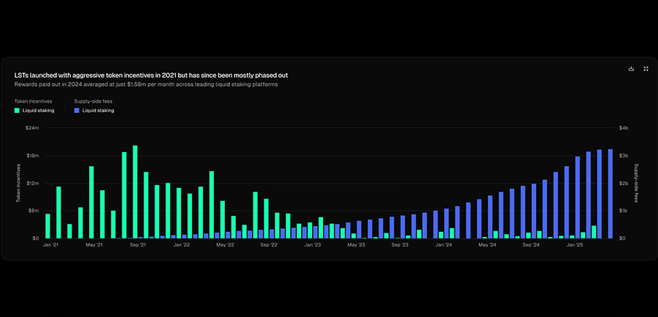
Lending in DeFi: Balancing Yield with Collateral Risk
Decentralized lending has reemerged as a core engine of capital efficiency in DeFi. By allowing users to borrow against digital assets, lending protocols enable leverage without liquidation-triggering asset sales — while lenders earn yield throughout the loan’s duration.
Today, the sector is thriving again. Platforms like Aave, Morpho, and Compound have seen stablecoin borrowing rates climb into the double digits, a stark contrast to the sub-5% levels during the last bear market. This resurgence is driven by a renewed risk-on mindset, with traders using stablecoins as a tool for leverage, yield-maximization, or strategic reallocation — often without incurring tax events.
Innovative stablecoin protocols like Ethena are also shaping this new landscape. By offering high APYs through a mix of staking rewards and perpetual funding rates, they’re attracting users eager to leverage exposure for both yield and airdrops.
But What About Collateral Risk?
As the market heats up, so do the risks — particularly around collateral quality. Not all assets used to back loans are created equal. Risk levels depend on multiple factors, including:
- The asset’s actual utility or value proposition
- On-chain liquidity relative to the loaned amount
- Degree of decentralization
- Holder concentration (i.e., how many whales could impact the price)
Evaluating lending risk means looking beyond APYs. Understanding the structure and health of accepted collateral is essential for any informed DeFi strategy.
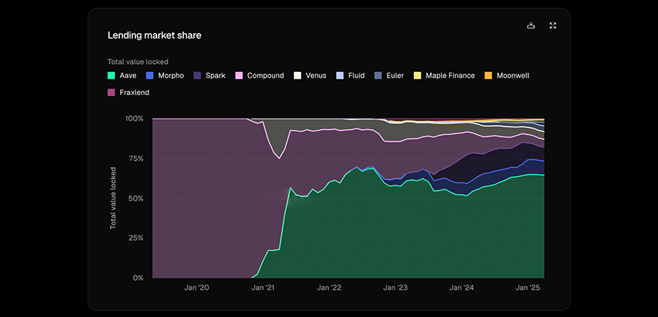

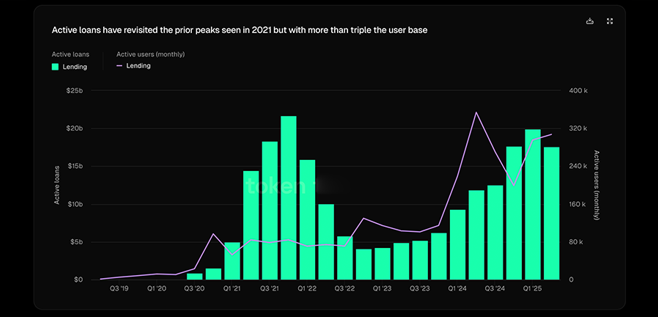
Lending Momentum: Growth Fueled by Smart Design & Higher Yields
DeFi lending saw explosive growth in 2024, especially in the fourth quarter, as risk appetite returned and borrowing surged. The result? A new wave of opportunity for lenders and platforms alike.
Aave, the dominant player in the space, led the charge. Outstanding borrows jumped more than 4x, from $3.4B to $14.5B by year-end. Its user base more than doubled, reaching nearly 60,000 unique borrowers. As demand spiked, USDC borrowing rates on Aave climbed from 6% APY to a peak of 17%, eventually settling around 10% — offering highly attractive yields for liquidity providers.
Meanwhile, Morpho emerged as a powerful alternative. With its isolated lending vaults, immutable protocol architecture, and curated risk approach, Morpho delivered a safer, more tailored lending experience — especially for niche assets. In just one year, its outstanding borrows soared from under $814M to over $2B, generating $57M in interest for lenders by the end of 2024.
This trend toward risk-isolated markets and smart protocol design is more than a technical improvement — it's reshaping DeFi lending. By reducing systemic risk and giving users more control, platforms are unlocking new layers of trust, capital efficiency, and sustainable growth.
Market Making in DeFi: Yield vs. Impermanent Loss
Market making is essential for decentralized exchanges (DEXs), allowing users to swap digital assets instantly. In return, liquidity providers (LPs) earn a share of trading fees. But behind this utility lies a trade-off that defines the entire sector: impermanent loss.
While market making powers DeFi’s liquidity layer, TVL growth across DEXs has cooled compared to the 2021 boom. The reason? Lingering concerns about capital loss — often amplified by media narratives. Impermanent loss occurs when the value of tokens in a pool diverges, resulting in LPs holding a disproportionate share of the underperforming asset. Even though trading fees can help cushion the impact, once liquidity is withdrawn, those losses often become permanent.
To tackle this, DeFi has embraced capital efficiency innovations like concentrated liquidity, allowing LPs to deploy assets within tighter price ranges for higher yield potential. But with that precision comes greater exposure — amplifying the risk of impermanent loss during volatility.
A safer alternative? “Stable” pools — pairing pegged assets like stablecoins or ETH derivatives. These pools reduce impermanent loss risk, making them a favorite for more conservative LPs. However, they often offer lower yields compared to riskier, volatile asset pairs.
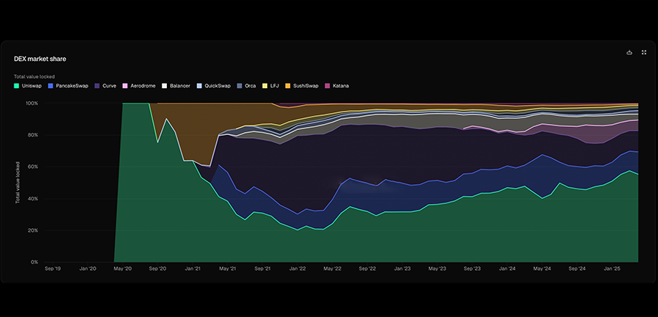
Aerodrome on Base: Tokenomics Meets Capital Efficiency
By tapping into ve(3,3) mechanics, Aerodrome has quickly emerged as the top DEX on Coinbase’s Base L2. Its model routes 100% of protocol fees to veAERO holders, creating powerful incentives for token locking and long-term alignment. This design fuels a feedback loop of emissions, bribes, and voting rewards, with all AERO emissions flowing directly to liquidity providers.
Built on a concentrated liquidity model inspired by Uniswap V3, Aerodrome balances high capital efficiency with aggressive tokenomics. The result? A fast-growing protocol that now dominates market share on Base**, demonstrating how clever mechanics and aligned incentives can reshape liquidity dynamics in DeFi.
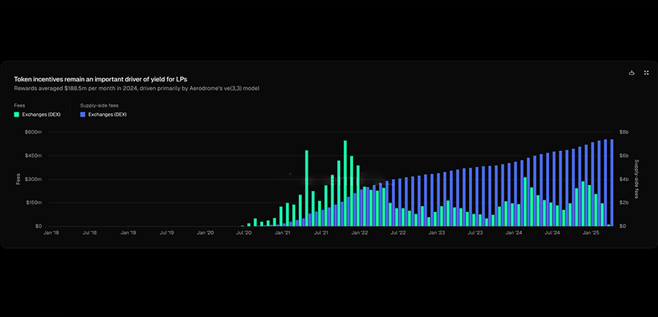
Bridging in DeFi: Opportunity Meets Centralization Risk
Cross-chain bridging plays a vital role in connecting blockchain ecosystems, enabling users to transfer assets between networks and giving liquidity providers a cut of the transfer fees. With the rise of Layer 2 rollups, the demand for secure bridging has surged, pushing TVL in bridging protocols steadily higher. Protocols like Across and Synapse are capitalizing on this momentum with improved security frameworks and more profitable fee models. But not all bridges are created equal. The space divides into two main categories:
- Trusted bridges rely on centralized operators — fast but vulnerable to single points of failure. Users must hand over their assets and hope the authority delivers.
- Trustless bridges, like those using optimistic mechanisms or ZK-proofs, aim to eliminate central dependencies, offering a more secure, decentralized experience.
Why It Matters
Historically, bridges were a favorite target for exploits. But 2024 marked a turning point: bridge-related losses dropped over 95% year-over-year, with only $19M compromised. This dramatic improvement reflects the sector’s maturity and a growing ability to mitigate previously critical vulnerabilities. Still, centralization risk remains a concern — especially for protocols still dependent on custodial systems. As DeFi becomes increasingly multichain, the security, design, and decentralization of bridging infrastructure will determine how far and fast assets can truly flow across networks.

Yield vs. Risk: Is Bridging Worth It?
Despite growing adoption, base yields for most bridge protocols remain relatively modest — hovering between 4–8%, and occasionally spiking to 10–15% when boosted by short-term token incentives. However, these inflated rewards often rely on unsustainable emissions, echoing early DeFi patterns that eventually collapsed.
Given bridging’s reputation as one of the most exploited sectors in crypto, LPs must weigh whether these yields justify the risk — especially when similar returns can often be found in less vulnerable areas of DeFi.
As the space continues to evolve, risk-adjusted yield will be the new benchmark, not just raw APY. And that means understanding the true cost of yield is more important than ever.

Case Study: Yearn stETH – When Yield Meets Layered Risk
The Yearn stETH Pool reveals how even blue-chip DeFi strategies can carry hidden risks. Built on Ethereum, the pool combines Lido’s stETH, Curve’s liquidity infrastructure, and Yearn’s yield optimization — creating a powerful yet complex stack of protocols working together to deliver returns.
But beneath the surface lies a classic DeFi issue: composability risk.
The DeFi Stack Effect
This strategy layers multiple smart contracts and token mechanisms:
- stETH, issued by Lido, relies on Ethereum’s Proof-of-Stake consensus.
- Curve provides liquidity between stETH and ETH through its AMM pools.
- Yearn deploys that liquidity for yield farming, adding optimization logic.
Each layer introduces potential vulnerabilities. If any piece — whether it’s Ethereum’s network, Lido’s staking mechanism, or smart contract logic in Curve or Yearn — fails or gets exploited, the entire stack becomes exposed. This is how cascading risks materialize in DeFi.
What RateX Score Sees
Complex, interconnected protocols like this often score well on asset quality but carry elevated structural risk due to composability. With RateX Score, investors can evaluate not just the token, but the entire system behind it — tracking sentiment, smart contract integrity, liquidity health, and dependency layers.
This case is a clear reminder: the most attractive yields often come with hidden complexity. Smart investors look beyond APY and into the architecture of the protocols they trust.
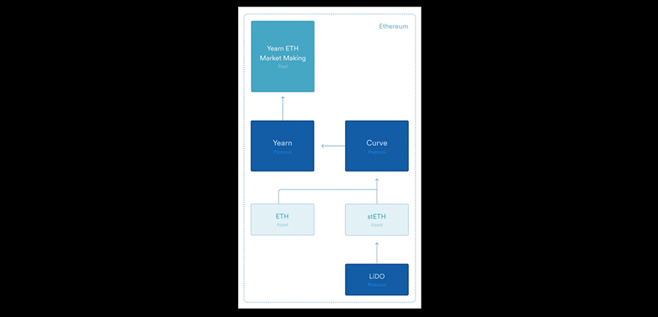
Key Takeaways: Navigating DeFi Risk with Confidence
Understanding risk is the foundation of any smart DeFi strategy. RateX Score, powered by our Meta Scoring Engine, helps decode complex threats — like smart contract exploits, liquidity shocks, and governance vulnerabilities — into clear, actionable insights.
Across the core pillars of DeFi, RateX Score enables you to explore opportunities while avoiding the traps:
- Staking is now DeFi’s backbone, with protocols like Lido holding the majority of TVL. But risks like slashing and centralized validator concentration remain. RateX Score helps you identify safer staking ecosystems with transparent metrics.
- Market Making drives liquidity but exposes LPs to impermanent loss and front-running. Our analytics highlight capital-efficient pools with reduced risk exposure.
- Lending boosts capital efficiency but suffers from liquidation cascades and collateral mispricing. RateX Score flags platforms with strong risk buffers and smart collateral frameworks.
- Bridging enables cross-chain movement, but remains vulnerable — historically one of the most exploited DeFi sectors. Our system detects which bridges have evolved to become more trust-minimized and resilient.
In a space where the landscape changes weekly, staying informed isn’t optional — it’s critical. RateX Score is your always-on AI copilot, scanning the market so you don’t have to.
Explore real-time risk ratings, token analytics, and whale signals at ratex.ai — and invest smarter, every step of the way.

 Get RateX Pro
Get RateX Pro

 06 Jun 2024
06 Jun 2024


